Abstract
OBJECTIVES: This study evaluated the hypothesis that greater integration and coordination between agencies within service systems is associated with greater accessibility of services and improved client housing outcomes. METHODS: As part of the Access to Community Care and Effective Services and Supports program, data were obtained on baseline client characteristics, service use, and 3-month and 12-month outcomes from 1832 clients seen at 18 sites during the first year of program operation. Data on interorganizational relationships were obtained from structured interviews with key informants from relevant organizations in each community (n = 32-82 at each site). RESULTS: Complete follow-up data were obtained from 1340 clients (73%). After control for baseline characteristics, service system integration was associated with superior housing outcomes at 12 months, and this relationship was mediated through greater access to housing agencies. CONCLUSIONS: Service system integration is related to improved access to housing services and better housing outcomes among homeless people with mental illness.
Full text
PDF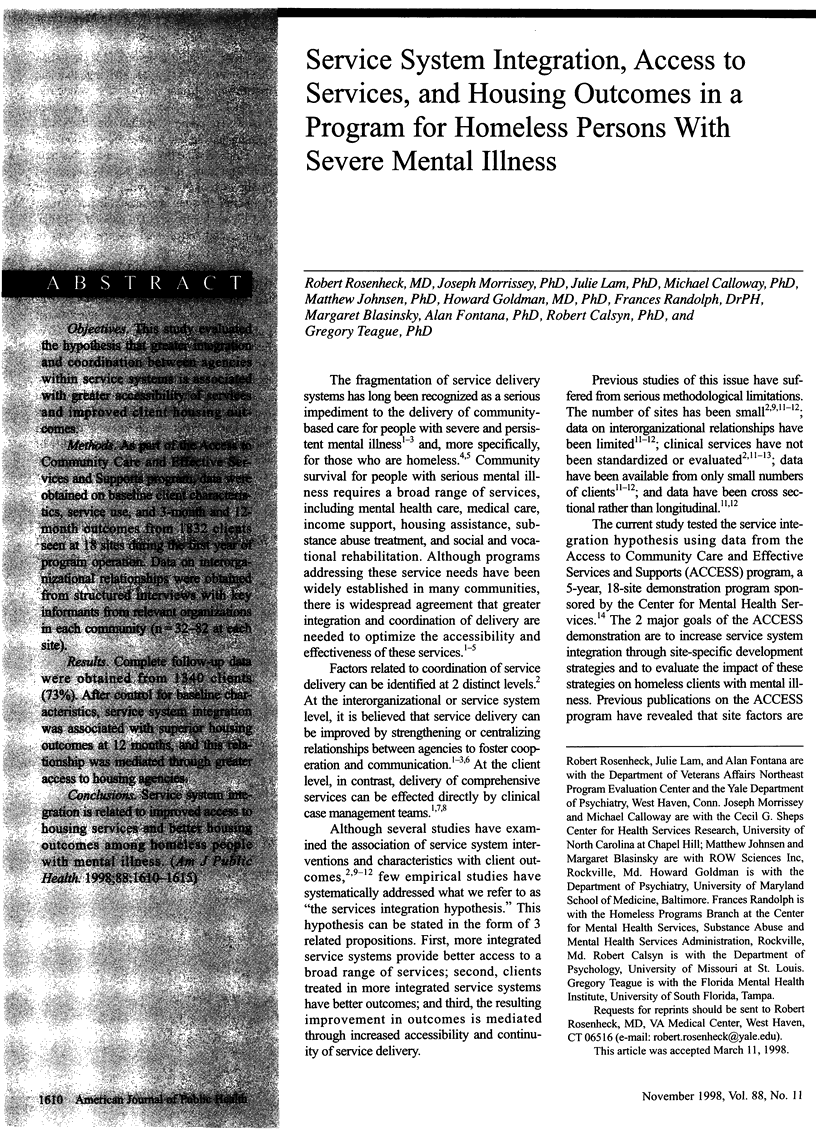
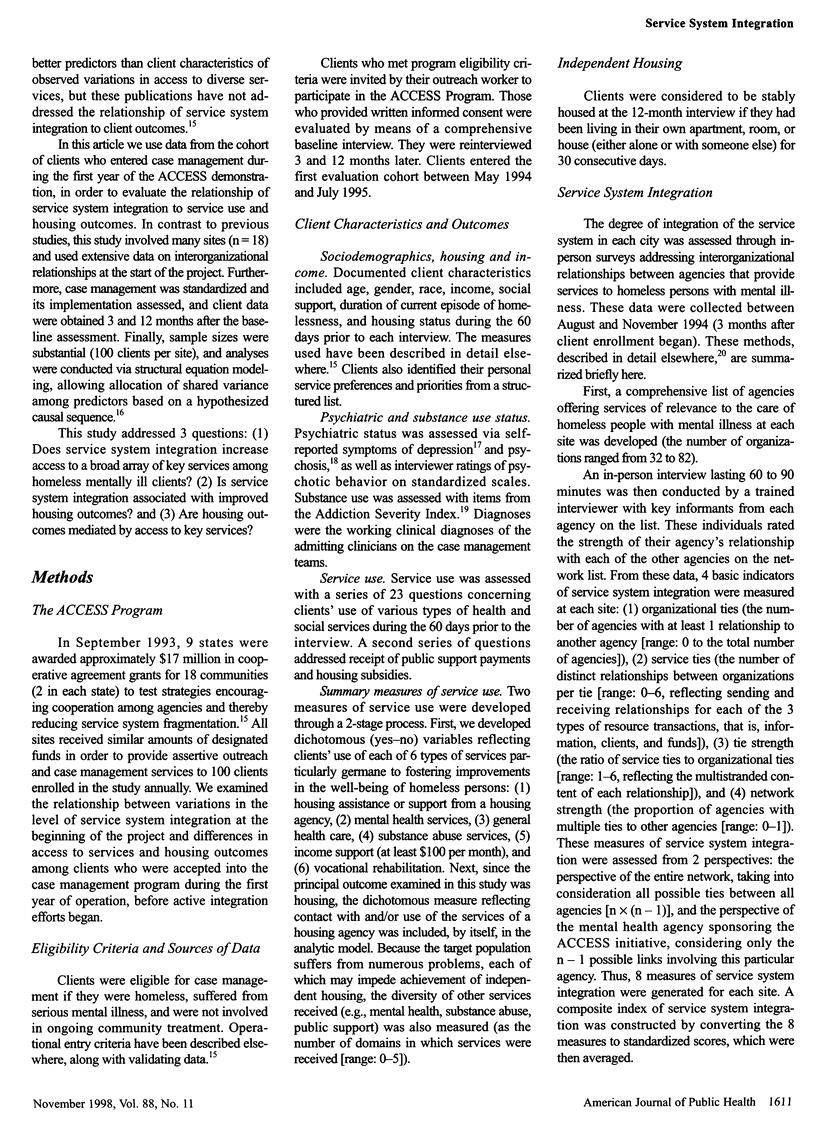
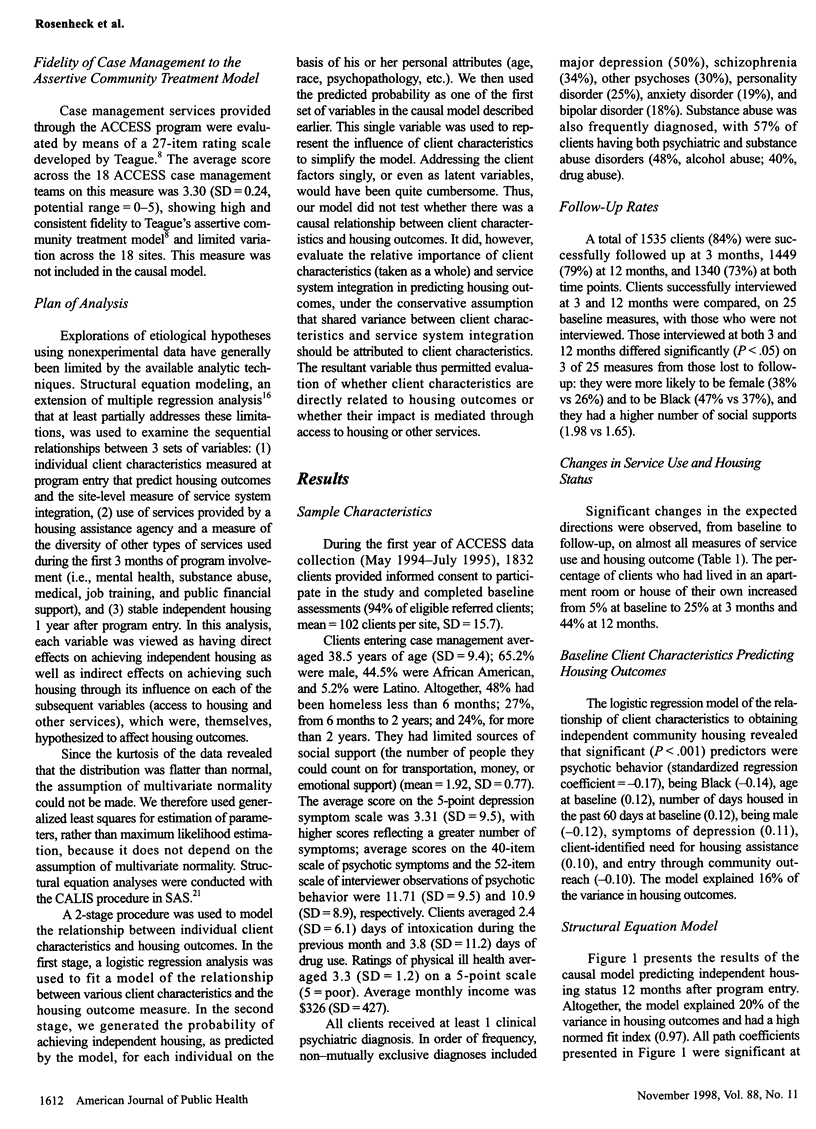
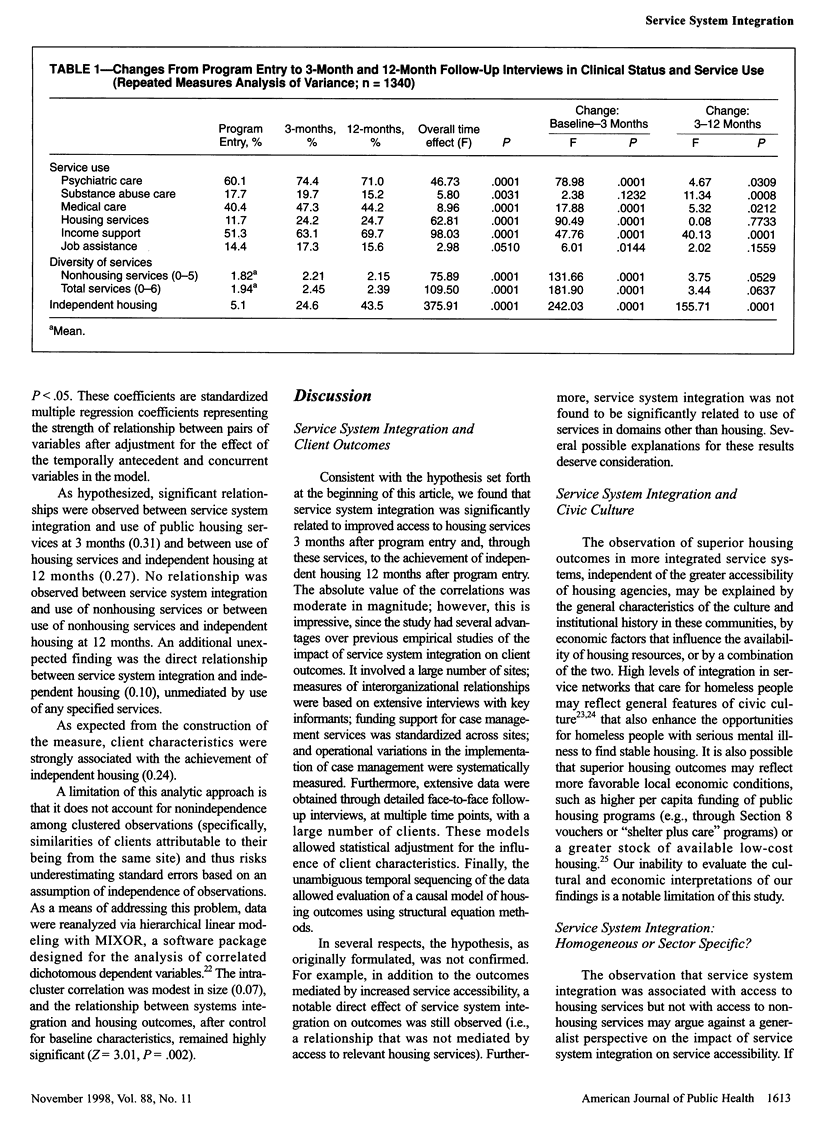
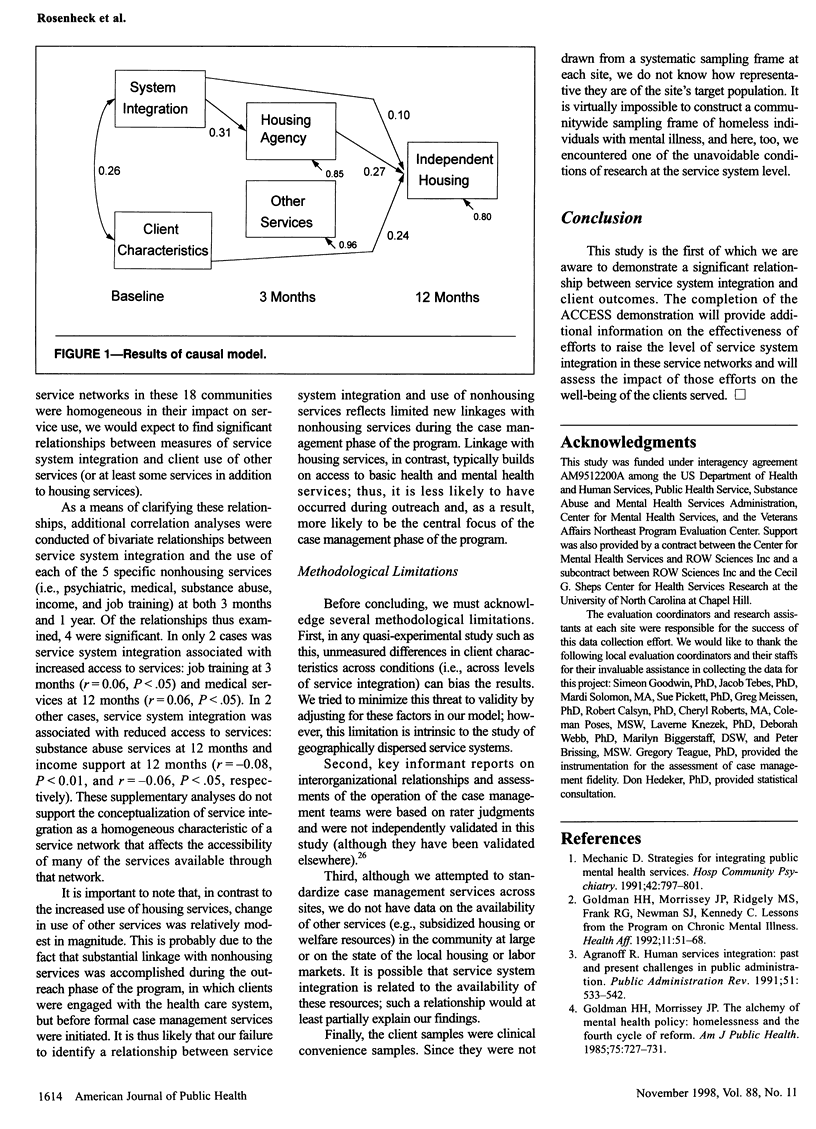
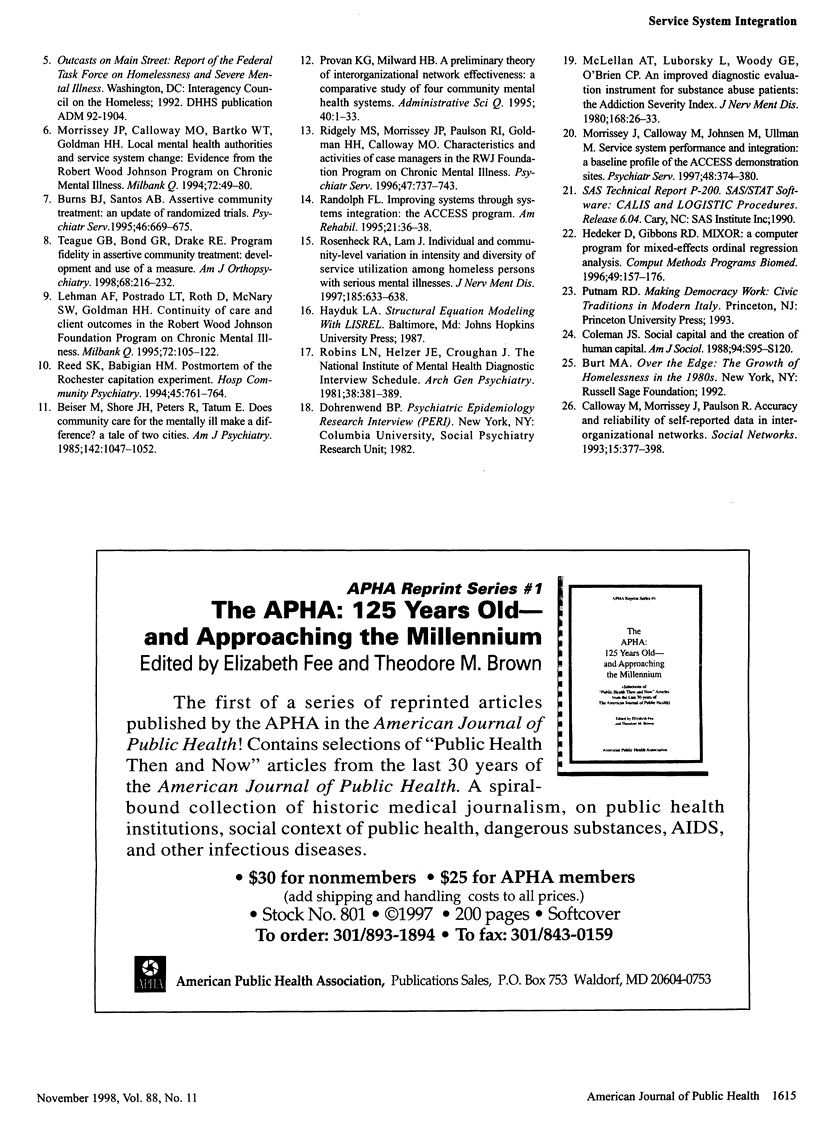
Selected References
These references are in PubMed. This may not be the complete list of references from this article.
- Beiser M., Shore J. H., Peters R., Tatum E. Does community care for the mentally ill make a difference? A tale of two cities. Am J Psychiatry. 1985 Sep;142(9):1047–1052. doi: 10.1176/ajp.142.9.1047. [DOI] [PubMed] [Google Scholar]
- Burns B. J., Santos A. B. Assertive community treatment: an update of randomized trials. Psychiatr Serv. 1995 Jul;46(7):669–675. doi: 10.1176/ps.46.7.669. [DOI] [PubMed] [Google Scholar]
- Goldman H. H., Morrissey J. P., Ridgely M. S., Frank R. G., Newman S. J., Kennedy C. Lessons from the program on chronic mental illness. Health Aff (Millwood) 1992 Fall;11(3):51–68. doi: 10.1377/hlthaff.11.3.51. [DOI] [PubMed] [Google Scholar]
- Goldman H. H., Morrissey J. P. The alchemy of mental health policy: homelessness and the fourth cycle of reform. Am J Public Health. 1985 Jul;75(7):727–731. doi: 10.2105/ajph.75.7.727. [DOI] [PMC free article] [PubMed] [Google Scholar]
- Hedeker D., Gibbons R. D. MIXOR: a computer program for mixed-effects ordinal regression analysis. Comput Methods Programs Biomed. 1996 Mar;49(2):157–176. doi: 10.1016/0169-2607(96)01720-8. [DOI] [PubMed] [Google Scholar]
- Lehman A. F., Postrado L. T., Roth D., McNary S. W., Goldman H. H. Continuity of care and client outcomes in the Robert Wood Johnson Foundation program on chronic mental illness. Milbank Q. 1994;72(1):105–122. [PubMed] [Google Scholar]
- McLellan A. T., Luborsky L., Woody G. E., O'Brien C. P. An improved diagnostic evaluation instrument for substance abuse patients. The Addiction Severity Index. J Nerv Ment Dis. 1980 Jan;168(1):26–33. doi: 10.1097/00005053-198001000-00006. [DOI] [PubMed] [Google Scholar]
- Mechanic D. Strategies for integrating public mental health services. Hosp Community Psychiatry. 1991 Aug;42(8):797–801. doi: 10.1176/ps.42.8.797. [DOI] [PubMed] [Google Scholar]
- Morrissey J. P., Calloway M., Bartko W. T., Ridgely M. S., Goldman H. H., Paulson R. I. Local mental health authorities and service system change: evidence from the Robert Wood Johnson program on chronic mental illness. Milbank Q. 1994;72(1):49–80. [PubMed] [Google Scholar]
- Morrissey J., Calloway M., Johnsen M., Ullman M. Service system performance and integration: a baseline profile of the ACCESS demonstration sites. Access to Community Care and Effective Services and Supports. Psychiatr Serv. 1997 Mar;48(3):374–380. doi: 10.1176/ps.48.3.374. [DOI] [PubMed] [Google Scholar]
- Reed S. K., Babigian H. M. Postmortem of the Rochester capitation experiment. Hosp Community Psychiatry. 1994 Aug;45(8):761–764. doi: 10.1176/ps.45.8.761. [DOI] [PubMed] [Google Scholar]
- Ridgely M. S., Morrissey J. P., Paulson R. I., Goldman H. H., Calloway M. O. Characteristics and activities of case managers in the RWJ Foundation Program on chronic mental illness. Psychiatr Serv. 1996 Jul;47(7):737–743. doi: 10.1176/ps.47.7.737. [DOI] [PubMed] [Google Scholar]
- Robins L. N., Helzer J. E., Croughan J., Ratcliff K. S. National Institute of Mental Health Diagnostic Interview Schedule. Its history, characteristics, and validity. Arch Gen Psychiatry. 1981 Apr;38(4):381–389. doi: 10.1001/archpsyc.1981.01780290015001. [DOI] [PubMed] [Google Scholar]
- Rosenheck R., Lam J. A. Individual and community-level variation in intensity and diversity of service utilization by homeless persons with serious mental illness. J Nerv Ment Dis. 1997 Oct;185(10):633–638. doi: 10.1097/00005053-199710000-00007. [DOI] [PubMed] [Google Scholar]
- Teague G. B., Bond G. R., Drake R. E. Program fidelity in assertive community treatment: development and use of a measure. Am J Orthopsychiatry. 1998 Apr;68(2):216–232. doi: 10.1037/h0080331. [DOI] [PubMed] [Google Scholar]


